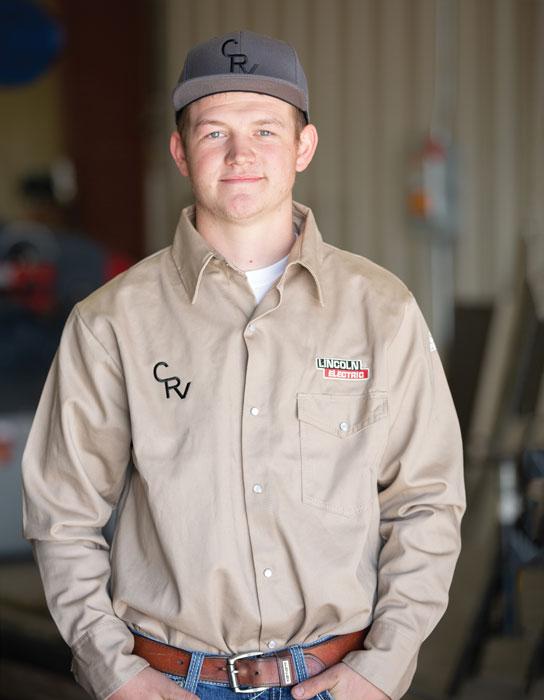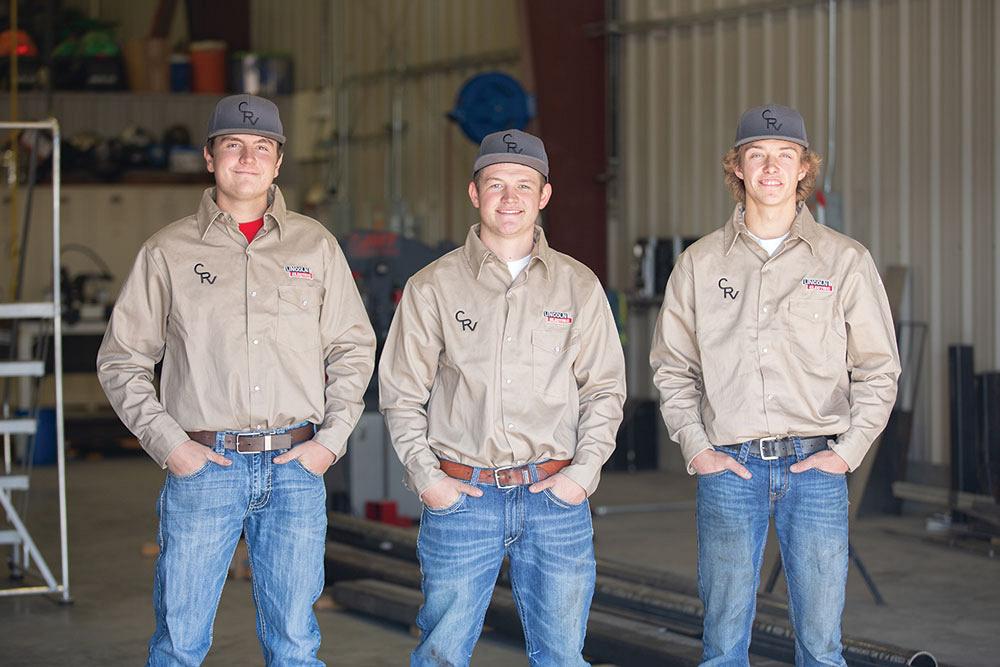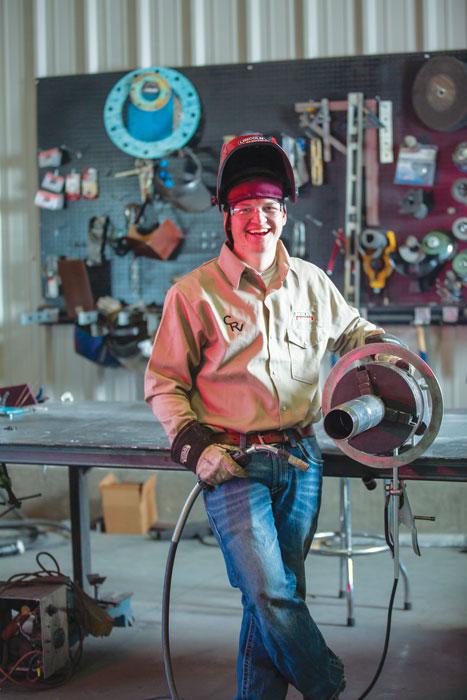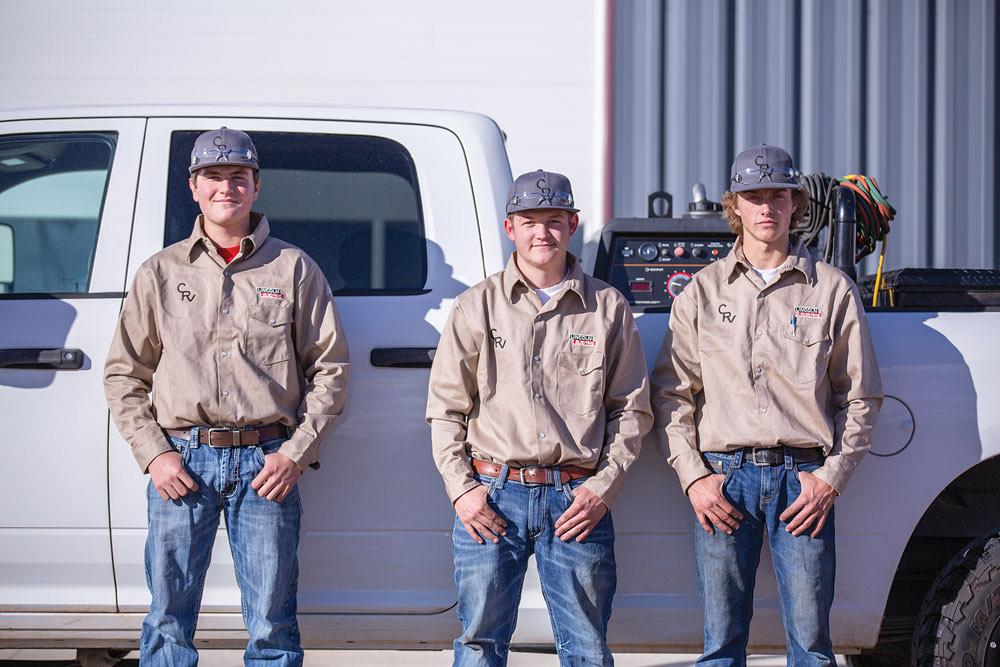- FMA
- The Fabricator
- FABTECH
- Canadian Metalworking
Categories
- Additive Manufacturing
- Aluminum Welding
- Arc Welding
- Assembly and Joining
- Automation and Robotics
- Bending and Forming
- Consumables
- Cutting and Weld Prep
- Electric Vehicles
- En Español
- Finishing
- Hydroforming
- Laser Cutting
- Laser Welding
- Machining
- Manufacturing Software
- Materials Handling
- Metals/Materials
- Oxyfuel Cutting
- Plasma Cutting
- Power Tools
- Punching and Other Holemaking
- Roll Forming
- Safety
- Sawing
- Shearing
- Shop Management
- Testing and Measuring
- Tube and Pipe Fabrication
- Tube and Pipe Production
- Waterjet Cutting
Industry Directory
Webcasts
Podcasts
FAB 40
Advertise
Subscribe
Account Login
Search
Former SkillsUSA champion finds success giving back
20-year-old welder, business owner serves as advocate for his peers
- By Amanda Carlson
- December 11, 2018
- Article
- Arc Welding

Looking back, Vincent is grateful for the first welding class and the instructors who invested so much time and energy into him. “I have no idea where I’d be if I didn’t have the opportunity to weld with the technical college while in high school.”
Try not to be impressed with Chandler Vincent, I dare you. The 20-year-old Vernal, Utah, native is actively making us all look bad, and he’s not even legally allowed to consume alcohol yet.
While most young millennials are sitting in classrooms, rushing the Greek system, or procuring fake IDs, Vincent is a welder, a business owner, a Skills-USA welding champion, and an advocate for other young welders.
Scratch that—a passionate advocate. Once he gets going on the topic of SkillsUSA, WorldSkills, mentoring fellow young welders, and what needs to be addressed to help young welders succeed, it’s hard to get him to stop.
Vincent is a believer in giving back. At 15 he had long resigned himself to be a high school dropout. And that’s where he began welding. If it hadn’t been for his welding teachers and his mom, his life might look very different. If he can advocate for others the way those in his life advocated for him, it’ll complete the circle.
When he was introduced to the SkillsUSA welding competition, he made it a goal to one day be the U.S. representative at WorldSkills.
And now he is a walking example of the phrase “Hard work pays off.” Why? Because that once aspiring high school dropout not only stayed in school, but opened CRV Welding & Fabrication at 16, earned a two-year welding degree at Utah State University Eastern where he trained under Mason Winters and Lon Youngberg, who helped him win the U.S. Invitational Weld Trials—making good on his goal to represent the U.S. at WorldSkills in Abu Dhabi in 2017. He has traveled all around the country and world and has partnered with the American Welding Society and Lincoln Electric to assist the next batch of U.S. welders in prepping for WorldSkills 2019.
In fact, Vincent recently returned from a trip to Budapest where he assisted Lincoln Electric at EuroSkills, where he provided specialized training to European student welders and made sure power sources were set up and operating properly.
It’s been a relatively short yet eventful journey in the welding world, with plenty more to come. Recently Vincent spoke to The WELDER® and talked about his story, what he’s up to now, and shared his thoughts on the industry as a whole.
TW: How did you get your start in welding?
CV: I had never struck an arc or been around welding until high school. I didn’t want to be in high school at all and had planned on dropping out. My mom signed me up for several classes, including a mechanics class, a cabinetry making class, and a welding class, that were offered by the high school through a technical college that is now called UB Tech. She just wanted to see if I’d like any of them enough to want to stay in school. Lo and behold, my first-hour class my freshman year was that welding class at the technical college. After I struck my first arc, I knew that welding was what my passion was going to be. It all went up from there. My welding instructor’s name was Kevin Mitchell, and he brought me in, took me under his wing, and brought me along really well. We had similar interests in life as far as the outdoors and hunting, so we hit it off pretty quickly.

Chandler Vincent started CRV Welding & Fabrication when he was just 16. Now at age 20, he is the oldest person at the company.
Welding was a challenge. I could do it really well one day and then the next I’d do it again on another piece of material in a different position and it would totally kick my butt. It wasn’t easy, and it was something that I had to put the work into every day to improve. I knew it would be needed in society and that it was going to be a good career. There was always a way to improve and it was always easy to see both improvement and failure. It was something that I could grow in and see it happening.
The biggest draw for welding for me was that none of it was easy and none of it was the same. From industry to industry there are different challenges, and I can always improve and grow as a welder for the rest of my life. I am learning daily on certain things—it’s a huge learning process and I like that.
TW: When did you open your business, and what kind of work do you specialize in?
CV: Most everyone in my family is self-employed and works within the oilfield industry. I was born and raised with the mentality of being a business owner. During my sophomore year of high school, after welding for only a year, it was so obvious to me that welding was something I was going to do for the rest of my life. So, I started a business at the age of 16 and was self-employed all the way through high school. I started out going door to door to local farmers asking if they needed anything built or repaired, like fences or corrals. Once I had an income, I was able to go out and buy one tool at a time. I got into more complicated work and just slowly expanded upon it. After I graduated from college, I was able to secure some investors thanks to the connections I made while competing and getting my name out there. I was able to lease this shop, which is a pretty good-sized space. I’ve got three employees right now—a secretary, a laborer, and another welder.
With the help of the investors, we’ve been able to get a nice plasma table, an ironworker, band saw, several different wire-feed welders, and some TIG welders. We’re doing it all right now. We’re growing and are mainly working in the oilfield industry right now. We’ve done a little bit of TIG work in Salt Lake City for the aerospace industry. That’s the kind of work we’d like to specialize in—high-quality, specialty TIG welding work, where we can show our talents. We’re growing every day and we are very busy. Each day we are improving and buying new tools.
A lot of the people that I’ve hired now are people that I’ve competed with who are around my same age. I know what they are capable of before they even come in. I haven’t hired anyone that I haven’t welded with.
An interesting fact is that right now I’m the oldest person at my business. My best welder isn’t 18 years old yet. He can really hold his own, and he’s more of a welder now than I’ve seen in a lot of people. He’s confident and a quick learner, young, and motivated. He gets to do his own jobs from start to finish without my assistance and he’s doing really well.
TW: How difficult is it to balance owning and operating a business with everything else you’ve got going on?
CV: I don’t get to weld on the projects as much as I used to because a lot of my day is spent on the phone or answering emails. But I try to be out there about four to five hours a day welding with the guys.
I’ve taken on more responsibility in training the U.S. welders for WorldSkills, so I spend a lot of time during the day emailing back and forth with competitors and managing an online forum hosted by the American Welding Society geared toward helping the competitors.

Vincent planned on being a high school dropout until he took a welding course taught by Kevin Mitchell. Immediately he was hooked.
TW: What does a typical workday look like for you?
CV: Back when I first got the business up and running, I was competing at the same time. I worked about 15 or 16 hours a day, which was crazy. It wasn’t good for my health and I didn’t get much sleep or rest.
I learned a lot from that experience and brought those lessons into how I run my business. At CRV we try to only work from about 7 a.m. to 6 p.m. We want to keep a healthy work schedule to stay fresh, which makes us more productive in the long run. Our production levels typically stay pretty high when we’re well rested. It’s not as many on-the-job hours as you’d think it would be.
But as far as taking phone calls and answering emails, that part of it is 24/7 and it never stops.
TW: What has the SkillsUSA/WorldSkills training and competition process done to prepare you as a business owner?
CV: I shut down my business temporarily when I moved to college because I knew I would be training for the competition every day. I decided at a really young age that I was going to be the U.S. representative at WorldSkills no matter what it took. I started training about a year before the first pretrial process. When I got invited to compete at nationals, I shut down everything and I went without having an income for about two years. I lived off of nothing and trained 15 to 16 hours every day for a solid year.
What all of that taught me was how to fight for my goals, how to do what needs to be done no excuses, dedication, discipline, and failure. One of the biggest things I learned was the art of failing. I tell the current welding contestants to fail often, to learn from their failures, and document them so that they don’t fail the same way twice. That lesson alone has helped me in my professional life as a business owner as well as in my personal life.
Another good thing it did was it taught me how to communicate with people. I was able to make connections with people from all around the world. Those things are huge in business—knowing people, knowing how to talk with people, and being comfortable traveling and meeting new people. I have found that to be a huge advantage.
One of the hardest parts of starting a business and branching out beyond farm work was that I didn’t have a lot of experience. But now my SkillsUSA and WorldSkills experience is a big seller. People know me before I walk in. When I walk into a business to try and get more work, more than half of them already know who I am and know my story. I am not intimidated to go out and get work. Potential customers know that I am capable of something before I even walk through the door. I probably would not be able to get the business I have if it wasn’t for the reputation I have built up through the welding competitions.
TW: Other than finding good welders, what other concerns do you have for the welding industry?

CRV Welding & Fabrication has three employees in addition to Vincent—a welder, a laborer, and a secretary. His experience in WorldSkills has helped open doors for business throughout the area.
CV: There’s a lot of discouragement out there on social media, and I think it makes it tough for young people to want to get involved in welding. There’s a Facebook page called Rate My Weld, designed for students to go on there and post a picture of their welds and for the older generations to give them advice. I’ve seen instances where these posters are purposely giving bad advice or making fun of these young welders. How in the world are we ever going to get young people in this industry when they are being treated like that?
There needs to be more apprenticeships to get young people the experience they need to be successful, to teach them the safe way to do things, and give them an opportunity to learn about the industry before they even get out of high school. And then employers and co-workers need to accept them when they get out. Young welders can be a huge asset because you can mold them into what you need them to be and reach them before they’ve had time to develop bad habits.
There needs to be more funding for schools and a pathway for industries to be in touch with technical colleges so they can communicate with the school on what they need from their students. That’s one of the biggest things I’m doing right now here in my hometown. The school board hosts representatives from local industry twice a year and these employers discuss with the board the skills we are seeing from the kids we’ve hired—what they know how to do and what they don’t. It’s a huge learning and growing experience for the schools, for industry, and for students. Connecting those three is the biggest factor for our industry’s success. We need to connect industry to the schools and the schools to the students.
I have no idea where I’d be if I didn’t have the opportunity to weld with the technical college while in high school. It took a lot of people’s time and dedication to get me where I am now. My high school and college instructors both put in a lot of time, and that’s what it takes to help make successful students. Often the teachers are so underpaid that they can’t provide that much time because they have to work another job.
I’ve had the opportunity to visit so many schools while I was traveling, and I can’t tell you how many instructors told me they would love for their kids to do what I did, or at least try, but they can’t because they don’t have the resources, the money, or the time. They are so milked dry of money that they use outdated machinery, and some have said they barely have enough clean metal for their students to weld on.
TW: What specific technology in industry right now are you most excited about?
CV: I’m excited for all of it. The welding machines themselves and their programs, waveforms, and the new ways of welding that are better with metal fusion and heat input. Some of these machines are taking what we’ve always done but putting less heat into it while achieving double the fusion. And they are doing it more efficiently, driving down electrical costs. Weld costs are going down and deposition rates are going up.
I’m excited to see what the future brings as far as welding modes and welding procedures. There are machines that have new and improved waveforms that can enhance a lot of features in the welding process in terms of speed and deposition rates. We are getting to where we can weld thicker materials a lot faster and with a lot less heat input. It’s incredible.
CRV Welding & Fabrication, 435-232-6426, www.crvwelding.com
Photos courtesy of Lacy Lange Photography, Vernal, Utah.
About the Author

Amanda Carlson
2135 Point Blvd
Elgin, IL 60123
815-227-8260
Amanda Carlson was named as the editor for The WELDER in January 2017. She is responsible for coordinating and writing or editing all of the magazine’s editorial content. Before joining The WELDER, Amanda was a news editor for two years, coordinating and editing all product and industry news items for several publications and thefabricator.com.
About the Publication
subscribe now

The Welder, formerly known as Practical Welding Today, is a showcase of the real people who make the products we use and work with every day. This magazine has served the welding community in North America well for more than 20 years.
start your free subscription- Stay connected from anywhere

Easily access valuable industry resources now with full access to the digital edition of The Fabricator.

Easily access valuable industry resources now with full access to the digital edition of The Welder.

Easily access valuable industry resources now with full access to the digital edition of The Tube and Pipe Journal.
- Podcasting
- Podcast:
- The Fabricator Podcast
- Published:
- 04/16/2024
- Running Time:
- 63:29
In this episode of The Fabricator Podcast, Caleb Chamberlain, co-founder and CEO of OSH Cut, discusses his company’s...
- Trending Articles
Sheffield Forgemasters makes global leap in welding technology

Welding student from Utah to represent the U.S. at WorldSkills 2024

Lincoln Electric announces executive appointments

Engine-driven welding machines include integrated air compressors

ESAB unveils Texas facility renovation

- Industry Events
16th Annual Safety Conference
- April 30 - May 1, 2024
- Elgin,
Pipe and Tube Conference
- May 21 - 22, 2024
- Omaha, NE
World-Class Roll Forming Workshop
- June 5 - 6, 2024
- Louisville, KY
Advanced Laser Application Workshop
- June 25 - 27, 2024
- Novi, MI



























